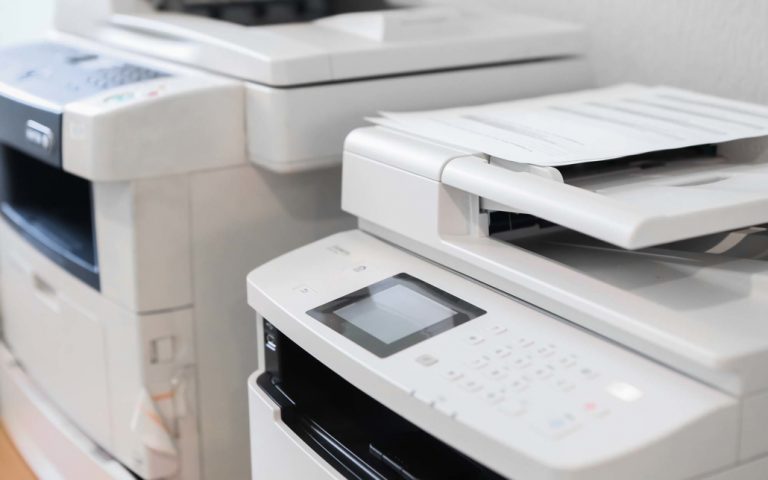Copier Speed and Warm-Up Time Explained
What Does Copier Speed Mean?
Copier speed is the rate at which a machine can produce copies or print pages.1 It is measured in pages per minute (PPM).
- Range: Copier speeds typically range from 15 to 120 PPM. The higher the PPM, the faster the copier can handle high-volume tasks.2
- Uniformity: The speed rating is the same regardless of whether it’s an office or industrial-sized machine.
There are two critical speed factors to consider:
- First Copy Speed:
- This is the time it takes for the machine to print the very first copy after the power is turned on or after a period of inactivity.
- This factor is crucial for firms that handle fast turnaround jobs or frequently send faxes, as it dictates how quickly the machine can respond to an initial command.
- Continuous Copy Speed:
- This is the constant, sustained rate (PPM) at which the machine prints subsequent copies once it has already warmed up and is operating at peak efficiency. This is the standard speed most people refer to.
What Does Warm-Up Time Mean?
Warm-up time is the duration required for a copier to become fully operational and ready to print or copy after being powered off or coming out of a deep sleep mode.3
- Average Time: Most average copiers require about 12 minutes to warm up. However, newer models can have warm-up times ranging from 0 to 120 seconds.
- Definition: It is the time from when the copier is powered on until it begins making copies at its fastest, continuous speed.
Why Do Copier Speed and Warm-Up Time Matter for Productivity?
Both speed and warm-up time have a direct and significant impact on an office’s daily productivity and efficiency.
| Factor | Impact on Productivity | User Profile |
| High Copier Speed | Saves employee time by reducing wait times for large print jobs, leading to faster completion of tasks and overall higher efficiency. | Higher-Volume Users who use the copier multiple times a day and need to process large documents quickly. |
| Low Copier Speed | Leads to wasted employee time waiting for printouts, which can result in lost revenue and customer dissatisfaction due to delays. | Infrequent Users who only need the copier occasionally and do not justify the cost of a faster, more expensive machine. |
| Fast Warm-Up Time | Allows employees to start printing immediately at the start of a shift or after a break, making it easier to maintain peak productivity. | Any business prioritizing minimal downtime and quick job initiation (e.g., fast turnaround services). |
When purchasing or leasing a copier, assessing both the continuous speed (PPM) and the warm-up time ensures you select a machine that aligns with your business’s workflows and estimated daily output volume.
That’s an excellent request. To illustrate the impact of speed and warm-up time, here is a comparison of current commercial copier models across different speed tiers, focusing on Pages Per Minute (PPM) and First Copy Out Time (FCOT) or Warm-Up Time.
Modern copier technology has significantly reduced warm-up times, especially when recovering from sleep mode.
Copier Speed (PPM) & Warm-Up Time Comparison
The key difference often lies between the Warm-Up Time (from a cold power-on) and the First Copy Out Time (FCOT) (from sleep or ready state).
| Speed Tier & Use Case | Example Model | Continuous Speed (PPM) | Warm-Up Time (from Power On) | First Copy Out Time (FCOT) |
| Mid-Volume / Workgroup | Kyocera ECOSYS M6535cidn | 37 ppm | Not specified (typically fast) | Not specified (estimated 6-10s) |
| Upper Mid-Volume / Departmental | Ricoh MP 3055 (B&W) | 30 ppm | < 24 seconds | 4.6 seconds |
| High-Volume Color MFP | Canon imageRUNNER ADVANCE DX C5870i | Up to 70 ppm (Color/B&W) | Not specified (typically low) | 2.7 seconds (B&W) / 3.7 seconds (Color) |
| High-Volume Color MFP | Xerox AltaLink C8270 | Up to 70 ppm | Not specified | Not specified |
| High-Volume Black & White | Sharp MX-M1206 (Production) | 120 ppm | 213 seconds (~3.5 minutes) | 3.2 seconds |
| Ultra-Fast Duplicator | Ricoh DD 3334 (Inkjet) | 130 ppm | Not applicable (Master-making process) | Master-making is ~18-20 seconds, then 1,000 copies in <8 mins. |
Analysis: What the Numbers Tell You
1. The Death of the Long Warm-Up
The traditional “12-minute warm-up” is largely a thing of the past for most modern office MFPs (Multi-Function Printers).
- Quick Start: Most contemporary models, like the Ricoh MP 3055, are ready from a cold start in under 30 seconds.
- Near-Instant Recovery: Many printers use energy-saving technologies (like Canon’s imageRUNNER ADVANCE DX series) that allow them to recover from sleep mode and print the first page in under 5 seconds. Epson’s Heat-Free PrecisionCore technology even boasts zero warm-up time.
2. First Copy Out Time (FCOT) is the New Warm-Up
For high-demand office environments, First Copy Out Time (FCOT) is a far more critical specification than the cold Warm-Up Time.
- A machine like the Canon C5870i delivers its first black-and-white page in just 2.7 seconds. This speed is crucial for small, quick jobs (like copying an ID or printing a single email) which make up a large portion of daily office tasks.
- A faster FCOT directly reduces the time an employee stands waiting at the machine, maximizing productivity throughout the day.
3. Speed Scales with Volume (and Price)
- 20–40 PPM: Excellent for small to medium-sized offices or workgroups with a daily print volume. They are robust but cost-effective.
- 40–70 PPM: Ideal for large departments or mid-sized businesses with high daily volume. These machines are the workhorses and represent the sweet spot for the best blend of speed, features, and cost.
- 90–130 PPM: This is the production-level or print-center tier. These are heavy-duty machines built for continuous, extremely high-volume output (e.g., printing marketing flyers, bulk mailings). Their cost and maintenance are significantly higher.
General Service and Quote Requests
If you plan to get copiers for your office, you can buy copiers or lease copiers. We can give you options for getting the copy machine that you want. You can contact our local copier leasing services department in your location.
For all services, call Clear Choice Technical Services:
- Phone: (913) 203-1300
- For copier leasing, request a quote today.
- For short-term rental inquiries, request a rental quote.
For dedicated Copier Repair Services in Kansas, please visit our Repair Services Website for immediate assistance. Our network is powered by Clear Choice Technical Services.






